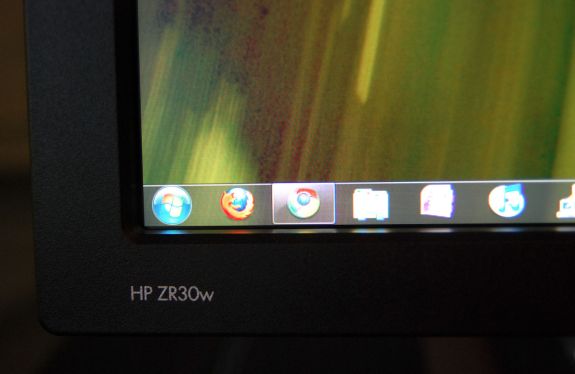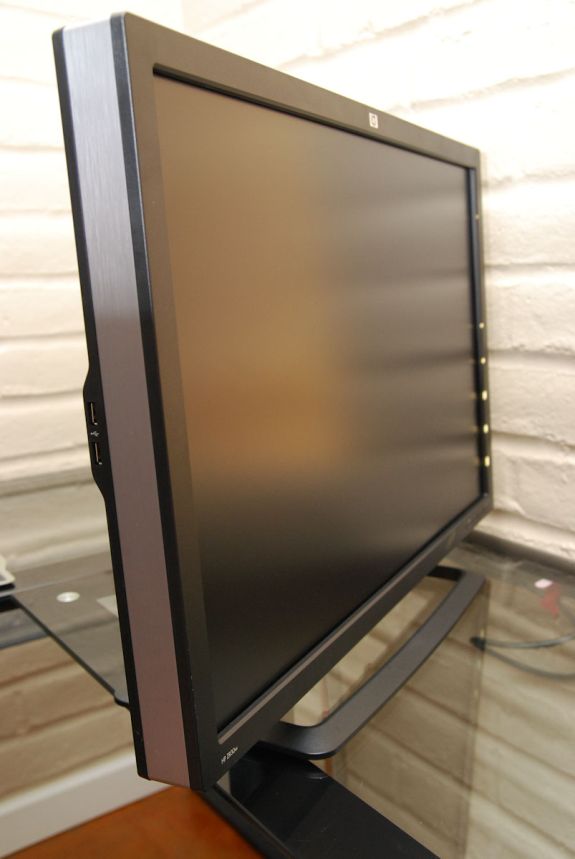A New 30" Contender: HP ZR30w Review
by Brian Klug on June 1, 2010 6:30 PM EST
Opining for an OSD
As I mentioned before, there’s no OSD to speak of. The only options exposed to users are input selection, brightness, and dynamic contrast. A blue LED at right flashes three times when you’ve reached the upper or lower brightness limits, and flashes four times when dynamic contrast is turned on, once when turned off. The LED is off when the display is in operation, and amber when in standby. The rest is up to you.
Spartan Scaling Selections
I also already touched on scaling which appears to be pretty barebones for reasons discussed earlier. You can pixel double by going with 1280x800, or go for native, or choose another resolution and everything upscaled with some smudging. There's no 1:1 option, or any options whatsoever. Honestly, I can’t think of any reasons why you wouldn’t drive an LCD at anything other than native resolution. The dot pitch of the ZR30w is fabulous at 0.250 mm, if you’re paying for those pixels, use them, then use DPI controls in the operating system if text and UI is too small. The ZR30w does scale other aspect ratios that I tested properly, but don't expect too much. Honestly it still makes no sense to drive a display this high resolution at anything but native.
Final Thoughts
The 30” segment of the LCD market demands the best of the best. It’s indisputably the ring in which every manufacturer wages battle with its flagship monitor. Solid execution here usually translates to solid performance for smaller size panels in the same lineup. Suffice it to say that HP’s 30 inch ZR series successor to the LP3065 doesn’t disappoint.
Spartan Scaling Selections
I also already touched on scaling which appears to be pretty barebones for reasons discussed earlier. You can pixel double by going with 1280x800, or go for native, or choose another resolution and everything upscaled with some smudging. There's no 1:1 option, or any options whatsoever. Honestly, I can’t think of any reasons why you wouldn’t drive an LCD at anything other than native resolution. The dot pitch of the ZR30w is fabulous at 0.250 mm, if you’re paying for those pixels, use them, then use DPI controls in the operating system if text and UI is too small. The ZR30w does scale other aspect ratios that I tested properly, but don't expect too much. Honestly it still makes no sense to drive a display this high resolution at anything but native.
Final Thoughts
The 30” segment of the LCD market demands the best of the best. It’s indisputably the ring in which every manufacturer wages battle with its flagship monitor. Solid execution here usually translates to solid performance for smaller size panels in the same lineup. Suffice it to say that HP’s 30 inch ZR series successor to the LP3065 doesn’t disappoint.
We would’ve liked to see just a bit more color accuracy, but the tradeoff for a dramatically bigger gamut is a good one to make. The ZR30w blew past the advertised 99% of AdobeRGB, coming in at just over 111% of the volume. It’s important to note that HP likely means coverage overlap of 99%, which the ZR30w does meet. But heck, having a volume bigger than the AdobeRGB volume is more notable. In person, the ZR30w is impressive all around. It’s bright, contrasty, and has colors that put my daily use monitors and others I’ve got laying around to shame; not an easy thing to do.
At an MSRP of $1,299, the ZR30w is priced aggressively and below its predecessor and competition. If you don’t mind lacking an extra DVI port, the increase in gamut volume is a notable difference. It’s likely that both lack of an OSD as well as accessory VGA, HDMI, component or composite inputs is related to the lack of a compatible control IC. Instead, there’s likely a simple scaler so we see minimal processing lag for an IPS panel, and unfortunately minimal user control. This is a bold move on HP’s part to continue for a second generation, but likely keeps cost and input processing lag low.
At an MSRP of $1,299, the ZR30w is priced aggressively and below its predecessor and competition. If you don’t mind lacking an extra DVI port, the increase in gamut volume is a notable difference. It’s likely that both lack of an OSD as well as accessory VGA, HDMI, component or composite inputs is related to the lack of a compatible control IC. Instead, there’s likely a simple scaler so we see minimal processing lag for an IPS panel, and unfortunately minimal user control. This is a bold move on HP’s part to continue for a second generation, but likely keeps cost and input processing lag low.
Interestingly enough, this is definitely the way that things are going for display controls, with a growing number offering DDC control as the exclusive option for tweaking settings. In practice, what HP offers with the front controls is almost all you need, so long as you can calibrate to your liking in software. Perhaps we might have gotten under a Delta E of 1.0 with some RGB sliders, but who’s to say?
The ZR30w is definitely a serious contender among 30” displays. It’s an attractive package that wows with above average color tracking, an impressive gamut, and a competitive price, but lacks some of the extra “accessory” inputs that consumers are starting to demand. That said, it looks like the ZR30w is a solid option if you’re looking for a 30” display with an unbeatable color gamut.












95 Comments
View All Comments
B3an - Friday, June 4, 2010 - link
Anyone?Brian Klug - Wednesday, June 9, 2010 - link
It depends on what you mean by colors. For real world color gamut, just compare the gamut to the 3008. I don't think we've tested that one yet.Otherwise, this is a 10 bit per channel monitor, so if you have an aware application you can drive more colors.
fenry - Friday, June 4, 2010 - link
The HP LP3065 had lower power specs! These are the numbers from HP:LP3065 ZR30w
176 185 Max Pwr (Watts)
118 139 Typical Power (Watts)
Maybe they mean it's more efficient when it's OFF (<2 Watts).
How do they get away with this being part of their advertising???
I've been paying careful attention to power draw of large monitors from some time, so I am extremely disappointed at HP for this misleading advertising. Check it out for yourself!
xismo - Friday, June 4, 2010 - link
I'm looking forward to the updated review. And honestly the workstation video cards are not that expensive. It's not like you need to get the Quadro FX 5800 to test 10-bit support in photoshop or maya. Like I mentioned earlier almost all of the workstation video cards have native 10-bit support so getting a Quadro FX1800 will actually cost you less or the same as 5870. Also ATI Firepro are generally cheaper and are just as good. NVIDIA hasn't updated their workstation cards for a while, while ATI released one just recently. But obviously if you'd like to get $3000+ high end card like the 5800 I can't stop you :)ProDigit - Saturday, June 5, 2010 - link
I don't care if it's a big screen, I just don't find a lot of justifying a screen that consumes about as much as my common desktop (The EeeBox for instance consumes roughly 20-25W, this screen 150-180W).Personally they would have done better with a LED backlit screen!
The price is also too much!
The last monitor you reviewed was a $300 26" screen, this one is only 4" larger diagonally, and boosts the 1080p resolution to 1600p, but still no reason to be almost $1k more!
Sorry to say, but this monitor is not a good buy; and unless you're busy professionally, you're better off buying 4x $300 26" monitors instead!
jiulemoigt - Sunday, June 6, 2010 - link
Considering even though they are only 10-12 bit displays I would have expected that any monitor claiming to have good color accuracy would be compared to the LCD3090W-BK-SV or LCD3090WQXi-BK.doclucas - Monday, June 7, 2010 - link
HP claim that there is no IC available for 30" is plain bullshit! There are many 30" that come with excellent OSD, such as my Dell 3008WFP (I also own HP LP3065 which I don't like compared to the Dell). Dell still make the best quality (affordable/mainstream) monitors, period.Gilbo - Tuesday, June 8, 2010 - link
Those monitors can implement OSD because they also have scalers.Scalers for 30" monitors have high input lag unfortunately, which makes them less desirable for some people.
CannibalisticH0b0 - Monday, June 14, 2010 - link
My main problem with this review is the inconsistent competitors used for comparison in the tests. The main thing I wanted to compare with other 30" monitors was input lag... yet no 30" monitors were compared with the new HP on that page. I agree that the figure looks low, but it would be nice to have that same exact test done (and shown) with the Dell 3007WFP, for example, which I believe is/was still the king of 30" monitors for gaming.mcklevin - Wednesday, June 16, 2010 - link
I would like to see how this fares against the apple cinema display. I recently purchased and returned the LG 3000H-BN because of a signal defect. However when it did work, I did notice that the anti-glare screen coat was highly distracting at the corners and off angle on a dark screen, especially in a dark room. Is it the same way with this display? In a lit room is a black screen noticeably gray?